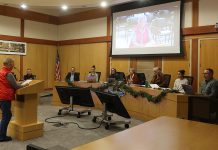It’s official. El Molino High School students will head to Analy High School this coming fall. The West Sonoma County Union High School District (WSCUHSD) board voted 3-2 to consolidate the schools during a meeting on March 10 in the face of an ongoing financial meltdown.
The decision sends Laguna High School students and the district office to the El Molino campus as part of the Fiscal Recovery Plan the board approved to address the roughly $2 million deficit projected for the 2022-23 year.
Vice Board President Jeanne Fernandes shared a timeline of WSCUHSD’s efforts to save El Molino from dwindling student enrollment since the 1980s.
It sought to change attendance boundaries in 1986, a regional district unification study was performed in 2006, the district built two facilities in the hopes of attracting more students — a new library in 1997 and a new performing arts center in 2018. The district also hired a public relations specialist, opened and then released a charter middle school to feed into El Molino and more, according to Fernandes.
Trustees Angie Lewis and Julie Aiello voted against the motion, joined by El Molino student representative Jeanne Broome and Analy student representative Satori McCullough, though legally the student votes carried no weight in the final decision.
“It would be ignorant to say that we are all going through this equally because that is not the case,” Broome said before the final call. “It is not ripping the BandAid off, because you are leaving a large section of the community and a larger section of your tax base feeling as though they have been entirely discounted.”
The El Molino student continued, “I want west county to thrive. I want west county to come out of these next few years changed. I think changes have to be made. I think a lot of positions will be lost and seats will be lost, and I think that those should be the things you sacrifice before you sacrifice a home, because that is what El Molino is. It is a home.”
The divided vote settled that the board would abide by a previous resolution originally intended as a placeholder plan, passed in November to merge in the 2021-22 year if neither Measure A for a district parcel tax nor Measure B for the west county transient occupancy tax won out.
The district didn’t meet the resolution’s other condition, with no net increase of $750,000 to speak of in its year-end general fund balance, Superintendent Toni Beal said.
The board had the option to amend the resolution to propose no consolidation or to postpone it until the 2022-23 year in the Fiscal Recovery Plan, but the motion carried to merge straight away with no further reductions planned so far in the 2022-23 year.
Board President Kellie Noe said broken systems of delivering education in west county force the district to make sacrifices in order to give students the best education they can under those circumstances until it’s ready to take on the structural inequities.
Her decision came down to the growing inequality of programs offered between Analy and El Molino.
“That has broken my heart honestly, every year,” she said, with the Forestville school consistently hit hardest because of its lower enrollment, while students continue to slip away to other schools.
Not only did Measure A and B return empty-handed, but the west county district unification study that some saw as the light at the end of the tunnel is farther off than expected, according to Noe.
She said Santa Rosa City Schools “has joined that conversation,” delaying Sonoma County Office of Education’s (SCOE) request for proposal process for a study now projected to take about two years to yield results. “And even at the end of that, you have the whole process to unify, so we’re probably four to five years out from any type of potential unification happening,” she said.
Meanwhile, waiting another year positions the district to consolidate all the same but make more extreme cuts, especially in the 2023-24 year, she said.
With both campuses remaining open, Noe spoke into the virtual yet fraught Zoom assembly a vision that the united student body could attend classes on both campuses, like joint agriculture classes in Forestville or other possibilities arising from the district unification study.
According to the meeting agenda report, the Superintendent’s Budget Committee came up with several options for the Fiscal Recovery Plan, but Beal said their nearly half-split vote tilted toward consolidation in the coming year over none at all or holding out until the 2022-23 year, considering a six-period day to preserve more time at the schools’ separate locations.
The Fiscal Recovery Plan now containing consolidation will be included in the second interim budget report approved that night certifying the district as positive, according to Chief Business Official Jeff Ogston. He said the district will fulfill its minimum reserve requirements without deficit spending this year or next year, while meeting reserve requirements in the 2022-23 year with $746,000 in deficit spending.
With consolidation comes preliminary layoffs
Now WSCUHSD staff find themselves in a sinking boat in that layoffs are coming. According to Mia Del Prete, director of human resources, the consolidation means cutting 45 sections, meaning nine full-time equivalent (FTE) positions.
She said some impacted teachers may receive a partial layoff, however, and that the numbers could change between March and May when the district issues final layoff notices.
Later on, the trustees approved the resolution to reduce or discontinue services based on the plan to join high schools onto one campus, bringing full or partial FTE cuts to sections from special education, band and other music subjects to leadership, physics and more, Del Prete said.
Del Prete said all employees facing the districtwide preliminary layoffs have been notified. According to Beal, these initial layoffs come from a worst-case scenario assessment based on student survey responses on what classes they’d take if consolidation happened.
She said many El Molino students didn’t finish the survey because they said they will not attend the district if consolidation goes forward.
The merger saves about 11 sections more than a shift to a six-period day, Del Prete confirmed for Broome, though Beal said most layoffs would carry through whether the district took either course of action.
For many, the appearance of saving 11 additional sections at the cost of losing an entire school in the rural locale was not a fair trade.
A divided community
For over an hour of tumultuous public comment leading up to the vote, those representing El Molino imparted the high school’s worth as a pillar of their community. Many attendees called for at least one year to build the bridge between the school’s communities for a smoother and less embittered transition.
Jeanne Chernila of Rio Nido and Guerneville said the receiving site should be El Molino if schools needed to merge because of its large space and more central location, opposing consolidation overall as hitting single parents, minority groups and people with lower socioeconomic status hardest.
“Consolidation of schools where the campus chosen as Analy puts the onus on community members less likely to successfully transition due to transportation and financial issues,” she said. “The loss of a school erodes a community’s social and economic base, its sense of community, identity and democracy. And the loss permanently diminishes the community itself.”
One parent said she’d pull out of the district if she had to deal with the traffic in Sebastopol, opposing consolidation. Another promised lawsuits and yet another warned the board of recalls as well.
“You can’t rush consolidation in five months and expect success,” said Gillian Hayes, one of El Molino’s most consistent advocates over months of consolidation talks.
She raised attention to a letter from over 550 listed parents, students, teachers and community members to the board that opposed consolidation but suggested ways to integrate students through joint activities over a year at their respective campuses if it went forward.
Clay Thistle of Forestville introduced himself as a member of the Superintendent’s Budget Committee. “Another discussion item from the committee was that El Molino in its own attendance area actually has fiscal stability,” he said, as its own basic aid district.
Vesta Copestakes backed the idea. “If El Molino can stand on its own because property tax does in fact pay for its salary, its expenses, then maybe it’s time for El Molino to break free of the west county school district and become its own school and fund itself,” she said.
Others spoke of kicking a can down the road, past the writing on the wall.
Rachel Allen urged for the schools to consolidate as soon as possible. “It’s absolutely magical to think that we can maintain two high school campuses with 500 kids at one place and 1,000 at another,” she said.
Prioritizing the kids means prioritizing academic excellence and programs made possible with strengthened numbers, Allen said. “Otherwise, we’re going to be a death by a thousand cuts, cutting, cutting, cutting and having two mediocre high schools no one wants to send their child to.”
Many community members urged the board to hold out for various government aid packages, but Ogston said sources such as the Elementary and Secondary School Emergency Relief Fund are intended for COVID-19 relief, like supporting students with higher needs, staff sanitation training and reopening or closing campuses.
There were teachers and school staff speaking out for and against consolidation, and while Lily Smedshammer didn’t press the board for a particular choice that night, the West Sonoma County Teachers’ Association (WSCTA) president said indecision hurts the community during her earlier association report.
Randy Hall, Analy’s digital media teacher said, “This reliance on one-time funds year after year to perpetuate the status quo leaves the district repeatedly and reactively laying off teachers again and again and again. This is abusive to the district’s arguably most valuable asset and leads to teachers leaving for greener pastures.”
He said, “The actions for the district for every single year I’ve been a teacher here has demonstrated a profound lack of long-range planning.”
What happens next is anyone’s guess, but the deep west county community that has weathered recent natural disasters, as well as the COVID-19 pandemic, have another eventful five months ahead living through the loss of El Molino High School.









